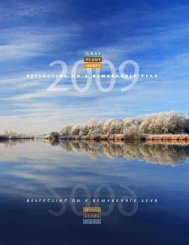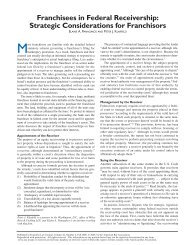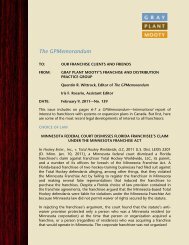Los Angeles Lawyer October 2008 - Gray Plant Mooty
Los Angeles Lawyer October 2008 - Gray Plant Mooty
Los Angeles Lawyer October 2008 - Gray Plant Mooty
You also want an ePaper? Increase the reach of your titles
YUMPU automatically turns print PDFs into web optimized ePapers that Google loves.
closing argument<br />
BY PAUL EISNER<br />
Will Someone Please Clean Up the Form Interrogatories Mess?<br />
THE ENACTMENT OF THE 1986 DISCOVERY ACT was designed to<br />
clean up many of the abuses that then plagued—and unfortunately,<br />
some of which still plague—the discovery process. However, the act<br />
created some new problems, and others have persisted despite the act’s<br />
clear language. One of the problems that existed prior to the act was<br />
the propounding of interrogatories with reference to other, unattached<br />
documents. The Discovery Act put an end to this abuse by requiring<br />
that each interrogatory must be complete. However, too many interrogatories,<br />
including some developed by the Judicial Council, ignore<br />
the rule of self-containment.<br />
The relevant language of Code of Civil<br />
Procedure Section 2030.060(d) states: “Each<br />
interrogatory shall be full and complete in and<br />
of itself. No preface or instruction shall be<br />
included with a set of interrogatories unless it<br />
has been approved under Chapter 17 (commencing<br />
with Section 2033.710).” 1 The<br />
California Court of Appeal has ruled that the<br />
requirement that an interrogatory be complete<br />
in and of itself is not satisfied when “resort must necessarily be made<br />
to other materials in order to complete the question.” 2<br />
Section 2030.060(f) provides, “No specially prepared interrogatory<br />
shall contain subparts, or a compound, conjunctive, or disjunctive<br />
question.” This language, which governs how special interrogatories<br />
may be drafted, is less encompassing than the phrase<br />
“each interrogatory” contained in Section 2030.060(d). Since there<br />
are only two types of interrogatories—attorney-drafted, specially<br />
prepared interrogatories and Judicial Council form interrogatories—<br />
giving effect to the broader language of Section 2030.060(d) requires<br />
that it apply to both types of interrogatories. While Code of Civil<br />
Procedure Sections 2033.710 et seq. authorize the Judicial Council<br />
to develop and approve form interrogatories and make rules regarding<br />
their use, that authority does not allow the Judicial Council to<br />
develop or approve interrogatories drawn in contravention of the provisions<br />
of the Discovery Act.<br />
Unfortunately, many Judicial Council form interrogatories were<br />
drafted in contravention of the self-containment rule of Section<br />
2030.060(d) and properly can be objected to on the grounds that they<br />
are incomplete. Form Interrogatory 15.1 and the similarly worded<br />
216.1, which ask about the denial of allegations in and affirmative<br />
defenses to the complaint, 3 violate the rule of self-containment<br />
because resort must be made to other materials, namely both the complaint<br />
and the answer. Form Interrogatories 17.1 and 217.1, which<br />
ask about the failure to unqualifiedly admit matters requested to be<br />
admitted, 4 also violate the rule of self-containment since they require<br />
resort to both requests for admissions and responses to the requests<br />
for admissions.<br />
Finally, the form interrogatories written for use in both unlimited<br />
jurisdiction and limited jurisdiction cases make use of the defined term<br />
“incident” in many of the questions. Both sets give the same two<br />
options for how the term “incident” is defined. The first option uses<br />
a preprinted definition: “INCIDENT includes the circumstances and<br />
events surrounding the alleged accident, injury, or other occurrence<br />
or breach of contract giving rise to this action or proceeding.” The<br />
second option provides: “INCIDENT means (insert your definition<br />
here or on a separate, attached sheet labeled “Sec. 4(a)(2)”).” The second<br />
option allows attorneys to define “incident” as they see fit.<br />
Under the first option, all form interrogatories that use the term<br />
“incident” may be incomplete, since one cannot determine the nature<br />
of the allegations without resort to the accusatory pleading. Use of<br />
Too many interrogatories, including some developed by the<br />
Judicial Council, ignore the rule of self-containment.<br />
the second option should avoid this problem, since the definition<br />
becomes part of the interrogatory set.<br />
Someone needs to clean up this mess. Unless and until Section<br />
2030.060(d) is revised, Form Interrogatories 15.1, 216.1, 17.1, and<br />
217.1 remain in violation of the self-containment rule, as do other<br />
form interrogatories using the term “incident” when the term is<br />
defined using the first option.<br />
■<br />
1 CODE CIV. PROC. §2030.060(d) (formerly CODE CIV. PROC. §2030(c)(5)).<br />
2 Catanese v. Superior Court, 46 Cal. App. 4th 1159, 1164 (1966). See also<br />
Discovery and Depositions §130 at 244 in CALIFORNIA JURISPRUDENCE 3d (2004).<br />
3 Form Interrogatory 15.1 asks:<br />
Identify each denial of a material allegation and each special or affirmative<br />
defense in your pleadings and for each:<br />
(a) state all facts upon which you base the denial or special or affirmative<br />
defense;<br />
(b) state the names, ADDRESSES, and telephone numbers of all PERSONS<br />
who have knowledge of those facts; and<br />
(c) identify all DOCUMENTS and other tangible things which support your<br />
denial and state the name, ADDRESS, and telephone number of the PER-<br />
SONS who has each DOCUMENT. (emphasis in original).<br />
4<br />
Form Interrogatories 17.1 and 217.1 ask:<br />
Is your response to each request for admission served with these interrogatories<br />
an unqualified admission? If not, for each response that is not an<br />
unqualified admission:<br />
(a) state the number of the request;<br />
(b) state all facts upon which you base your response;<br />
(c) state the names, ADDRESSES, and telephone numbers of all PERSONS<br />
who have knowledge of those facts; and<br />
(d) identify all DOCUMENTS and other tangible things that support your<br />
response and state the name, ADDRESS, and telephone number of the PER-<br />
SON who has each such DOCUMENT or thing. (emphasis in the original).<br />
Paul Eisner is with the law offices of Duncan David Lee.<br />
44 <strong>Los</strong> <strong>Angeles</strong> <strong>Lawyer</strong> <strong>October</strong> <strong>2008</strong>







